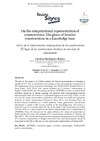Identificador persistente para citar o vincular este elemento:
https://accedacris.ulpgc.es/jspui/handle/10553/58378
| Campo DC | Valor | idioma |
|---|---|---|
| dc.contributor.author | Rodríguez-Juárez, Carolina | - |
| dc.date.accessioned | 2019-12-12T19:20:13Z | - |
| dc.date.available | 2019-12-12T19:20:13Z | - |
| dc.date.issued | 2019 | - |
| dc.identifier.issn | 0718-0934 | - |
| dc.identifier.other | WoS | - |
| dc.identifier.uri | https://accedacris.ulpgc.es/handle/10553/58378 | - |
| dc.description.abstract | The aim of this paper is to further explore the formal representation of meaning as regards Level 1 (L1) or non-kernel constructions in the computational environment of the multipurpose lexico-conceptual knowledge base FunGramKB (Perifian-Pascual & Arcas-Tunez, 2010, 2014) with special reference to L1-locative constructions in English. FunGramKB uses the parsing prototype ARTEMIS in order to automatically transduce fragments of natural language and generate their corresponding semantic representation under the format of a conceptual logical structure (CLS). Firstly, we aim to revise the criteria used in order to determine what factors can modify the argumental structure of kernel constructions (Fumero & Diaz, 2017). Any deviation from the kernel construct attributed to a verbal predicate, whose grammatical and semantic information is stored in the Lexicon module of the knowledge base, will result in a particular type of L1-construction that has to be stored in the Grammaticon module, and that will have a direct impact on the formal representation of L1-constructions in ARTEMIS. Thus, the first part of the paper addresses the notion of construction in FunGramKB and revises the catalogue of L1-constructions proposed by Fumero and Diaz (2017). The second part focuses on the computational representation of the family of L1-locative constructions in English and shows how their idiosyncrasies should be formalized in the CLS so that they can be satisfactorily implemented in FunGramKB. | - |
| dc.description.abstract | El objetivo de este artículo es avanzar en el análisis de la representación formal del significado en relación con las construcciones de nivel 1 o constructos no kernel en el marco computacional de la base de conocimiento léxico-conceptual y multipropósito denominada FunGramKB (Periñán-Pascual & Arcas-Túnez, 2010, 2014), con especial referencia a las construcciones locativas en lengua inglesa. FunGramKB utiliza el prototipo de parseador ARTEMIS con el fin de transducir automáticamente fragmentos de lenguaje natural y generar su representación semántica bajo el formato de una estructura lógica conceptual. En primer lugar, nos proponemos revisar los criterios utilizados a la hora de determinar qué factores pueden modificar la estructura argumental de las construcciones kernel (Fumero & Díaz, 2017). Cualquier desviación del constructo kernel de un predicado verbal, cuya información gramatical y semántica se encuentra almacenada en el módulo del Lexicón de la base de conocimiento, conllevará que este constructo sea reconocido como una construcción de nivel 1 específica que tiene que almacenarse en el módulo del Gramaticón y que tendrá un impacto directo en la representación formal de las construcciones de nivel 1 en ARTEMIS. La primera parte de este trabajo aborda la noción de construcción en FunGramKB y revisa el catálogo de construcciones de nivel 1 propuesto por Fumero y Díaz (2017). La segunda parte se centra en la representación computacional de la familia de construcciones locativas de nivel 1 y muestra cómo deben formalizarse las idiosincrasias de estas construcciones en la estructura lógica conceptual con el fin de que puedan implementarse satisfactoriamente en FunGramKB. | - |
| dc.language | eng | - |
| dc.relation.ispartof | Revista Signos | - |
| dc.source | Revista Signos [ISSN 0718-0934], v. 52 (100), p. 357-380 | - |
| dc.subject | 5701 Lingüística aplicada | - |
| dc.subject.other | ARTEMIS | - |
| dc.subject.other | Conceptual logical structure | - |
| dc.subject.other | Constructions | - |
| dc.subject.other | FunGramKB | - |
| dc.subject.other | Locative constructions | - |
| dc.subject.other | Construcciones | - |
| dc.subject.other | Construcciones locativas | - |
| dc.subject.other | Estructura lógica conceptual | - |
| dc.title | On the computational representation of constructions: The place of locative constructions in a knowledge base | - |
| dc.title.alternative | Acerca de la representación computacional de las construcciones: El lugar de las construcciones locativas en una base de conocimiento | - |
| dc.type | info:eu-repo/semantics/Article | - |
| dc.type | Article | - |
| dc.identifier.doi | 10.4067/S0718-09342019000200357 | |
| dc.identifier.scopus | 85072756348 | |
| dc.identifier.isi | 000474891800007 | - |
| dc.contributor.authorscopusid | 56469790200 | |
| dc.description.lastpage | 380 | - |
| dc.identifier.issue | 100 | - |
| dc.description.firstpage | 357 | - |
| dc.relation.volume | 52 | - |
| dc.investigacion | Artes y Humanidades | - |
| dc.type2 | Artículo | - |
| dc.contributor.daisngid | 7085255 | |
| dc.contributor.wosstandard | WOS:Rodriguez-Juarez, C | |
| dc.date.coverdate | Agosto 2019 | |
| dc.identifier.ulpgc | Sí | es |
| dc.description.sjr | 0,364 | |
| dc.description.jcr | 488,0 | |
| dc.description.sjrq | Q1 | |
| dc.description.jcrq | Q3 | |
| dc.description.ahci | AHCI | |
| dc.description.ssci | SSCI | |
| dc.description.erihplus | ERIH PLUS | |
| item.grantfulltext | open | - |
| item.fulltext | Con texto completo | - |
| crisitem.author.dept | GIR IATEXT: Variación y Cambio Lingüístico | - |
| crisitem.author.dept | IU de Análisis y Aplicaciones Textuales | - |
| crisitem.author.dept | Departamento de Filología Moderna, Traducción e Interpretación | - |
| crisitem.author.orcid | 0000-0001-6711-8597 | - |
| crisitem.author.parentorg | IU de Análisis y Aplicaciones Textuales | - |
| crisitem.author.fullName | Rodríguez Juárez, Carolina Fátima | - |
| Colección: | Artículos | |
Visitas
116
actualizado el 17-feb-2024
Descargas
98
actualizado el 17-feb-2024
Google ScholarTM
Verifica
Altmetric
Comparte
Exporta metadatos
Los elementos en ULPGC accedaCRIS están protegidos por derechos de autor con todos los derechos reservados, a menos que se indique lo contrario.
